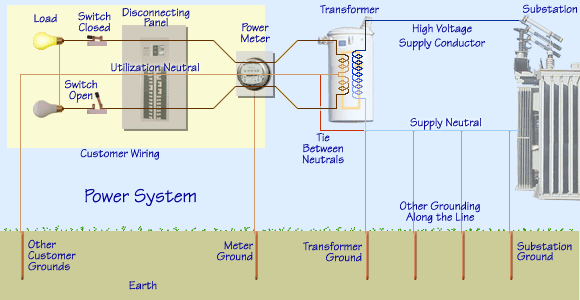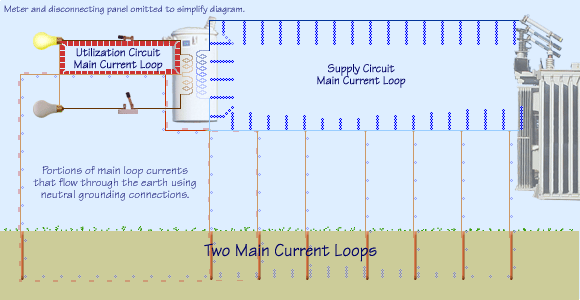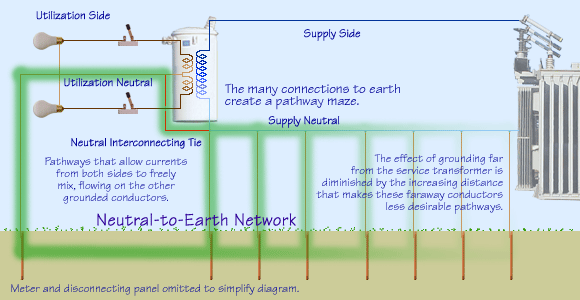Rural Power Systems |
|
|
|
A typical rural power system, in its last few miles to the farmstead, is a
single-phase line, one of the branches of a
three-phase power delivery system.
The single-phase line is made up of a phase wire energized at a
high electric potential
and insulated from the earth, and a neutral conductor, which is at earth potential
because it is connected to the earth.
|
|
Near the farmstead,
the phase wire is connected to one terminal
and the neutral wire to the other terminal on the supply side of the transformer. The purpose of the transformer is to
lower the voltage to safer, more practical levels. This ability to reduce voltage to usable levels is
a major benefit of alternating current systems.
|
|
Coming out of the transformer is the standard
three-wire 120/240-volt service found in most homes. The service wires are typically run to
an outdoor utility meter installed at a key location on a farmstead
to measure electric power usage. From there, the wiring typically continues
to a disconnecting panel from which all circuits feeding the
farmstead originate.
|





|
 
|
 Two Current Loops
Two Current Loops |
|
In order for any electrical system to operate, there must be a
closed electric circuit loop.
At a farm, there are two basic loop circuits involved, each with
its own current: the high-voltage circuit (primary) on the
supply side of the transformer and the low-voltage circuit
(secondary) on the utilization side. The high-voltage circuit
is physically isolated from the low-voltage circuit. Inside
the utility transformer, the two circuits are magnetically coupled,
allowing electric energy to be transferred by means of a
magnetic field.
The current on the primary circuit is separate from current(s)
on the secondary circuit, although the two currents do mix on grounded
conductors and in the earth. |





|
 
|
 Neutral Interconnection
Neutral Interconnection |
|
An external connection is intentionally established between
the primary neutral conductor of the high-voltage circuit feeding the transformer
and the secondary neutral conductor of the low-voltage circuit coming out of the
transformer. This allows protective devices such
as fuses to de-energize the high-voltage circuit in the event of a fault inside the
transformer (high-voltage wires coming into contact with low-voltage wires).
If not for the connection between the primary and secondary neutrals,
the low-voltage circuit could become energized at a high voltage. It is a widely
used and time-proven construction practice required by electrical code. It protects
people and animals from harm in case of system breakdown. |





|
 
|
|
The neutral interconnection wire creates a network
between the neutral and the earth that extends across the transformer
as shown in the diagram below. |

|
|
This network allows current to cross over from one neutral conductor onto
the other. This intermingling makes tracing and learning about earth currents more complicated, as we shall see later
[Intermingling].
|
|
|





|
